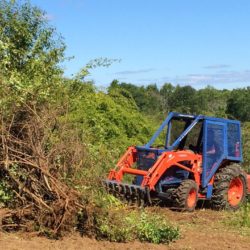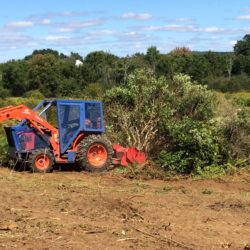Written by Zach McElgunn, ELA Staff This month’s tips, tricks, and techniques draw on the work and advice of Rosmarie Lohnes (Designer President, Helping Nature Heal). Rosmarie joined ELA members…
Restoration
Restoring a Pitch Pine-Oak Upland Forest at Norcross Wildlife Sanctuary
Restoring a Pitch Pine-Oak Upland Forest at Norcross Wildlife Sanctuary Written by: Dan Wilder, Director of Wildlife Ecology, Norcross Wildlife Foundation Norcross Wildlife Foundation is located in south-central Massachusetts and…
Can the Soil Seed Bank Save Us?
By Nathan Lamb
Imagine two woodlands. Both have deciduous, fire-adapted trees overhead. One has widely spaced trees, and sunlight reaches a diverse community of grasses, sedges, and forbs. The other has a dense thicket of invasive shrubs that shades out all but the earliest spring ephemerals. Will removing the invasive shrubs and exposing the bare soil trigger a profusion of native plants, restoring the diverse community that lived there hundreds of years ago?
Reducing Invasive Plants and Recovering a Healthy Plant Community
By Ellen Snyder
In southeastern New Hampshire, where I work with landowners and communities on land stewardship, managing invasive plants is a constant struggle. As the Land Stewardship Coordinator for the Town of Durham, I’m guiding three restoration projects on town conservation land. It was hard not to be overwhelmed by the pervasiveness of invasive plants on all three properties. To avoid invasive paralysis, I keep my focus on the goal: restoration of a place to a mostly self-sustaining, healthy plant community. The reward is a restored landscape brimming with native plants and native beneficial insects.
Lessons Learned on A Native Plant Journey
By Cathy Weston
A visit to Cape Cod brings us to a 2-acre fallow farmland property where the homeowner/gardener has spent years cutting back invasive plants to return the land from an Old Field habitat to a Coastal Woodland. The amount of effort to remove and keep invasives at bay could seem a daunting task, but this homeowner persevered and with trial and error created a beautiful ecological habitat for both herself and the wildlife her property now calls home.
Restoring the Wetlands of Morris Arboretum
by Eloise Gayer
Morris Arboretum of the University of Pennsylvania is well known for its abundance of mature trees and horticultural displays. In 2001 the Arboretum began the restoration of a drained wetland that would not only serve as a blueprint for other wetland restoration projects but also create more educational opportunities for the entire community. Learn about the history of this wetland, that was farmland at the turn of the century then one hundred years later was reverted back into a natural wetland.
Planting Edible Native Species – A Case Study from Massachusetts
by Russ Cohen
A newly daylighted stream at Willard’s Woods in Lexington, MA presented a serendipitous opportunity for introduction of edible native plants to the conservation area. At a double session focused on propagating and planting edible native plant species, Russ Cohen and co-presenter Georgia Hann included this 2017 project at ELA’s 2020 Conference & Eco-Marketplace in March. Here, Russ follows up the conference session with a deeper dive into the Willard’s Woods project.
Goats as an Ecological Management Option for Invasive Plants
by Sandy Vorce
“Gotta get a goat” was the author’s mantra a decade ago as she struggled against bittersweet, buckthorn, and multiflora rose to regain a portion of meadow at Mass Audubon’s property in Belmont, MA. Her wish was granted, and the property now successfully utilizes a four-hoofed crew for control of invasive plants. Read the article.
Native Plants Shine in Streambank Restoration
by Krissy Boys
Four years after replacement of a streambank water control structure, native grasses, sedges, and forbs planted at the site have become well established. Most species are thriving and have propagated themselves by self-sowing in the streambank gardens. Only two species out of 58 genera completely failed.
Controlling Invasive Species During Restoration
Contributions by Julie Snell and Ellen Snyder
Invasive plants can cause significant challenges at restoration sites. We asked ELA two members to share their experiences managing invasive plants and to offer tips for success.
From Wasteland to Wildflower Meadow at Greenfield Community College
by Maureen Sundberg
A campus wildflower meadow tucked onto a slope at Greenfield Community College was designed as part of a larger outdoor learning lab that includes a botanical garden, wetland garden, permaculture garden, and raingarden. Two years after planting, the meadow has become an oasis of learning for students across the academic spectrum.
Functional Fire – Prescribed Burning at Winterthur
by Madeline Banks First Things First Any kind of prescribed burning has a lot of thought and careful planning behind it. Everything from safety to environmental impact need to be…











